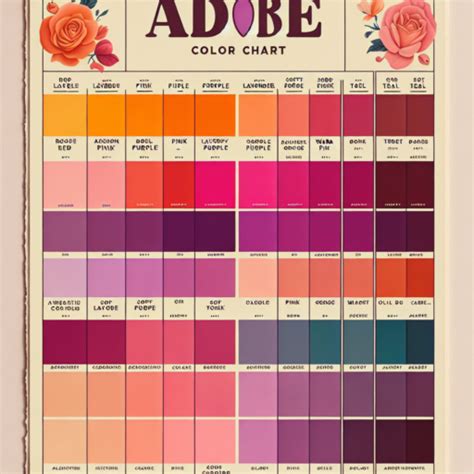What is an Adore Color Chart?
An adore color chart is a systematic arrangement of paint and stain colors curated by experts. It is designed to eliminate the guesswork out of selecting color combinations and provides a consistent and reliable way to achieve aesthetically pleasing results.

Color Theory and the Adore Color Chart
Color theory forms the foundation of the adore color chart. It consists of three primary colors (red, yellow, and blue), three secondary colors (orange, green, and purple), and six tertiary colors (red-orange, yellow-orange, yellow-green, blue-green, blue-violet, and red-violet). These colors are arranged on a color wheel, with the primary colors forming a triangle at the base.
The adore color chart employs color theory to organize colors into harmonious groups. These groups include:
- Complementary colors: Opposite each other on the color wheel (e.g., red and green)
- Analogous colors: Adjacent to each other on the color wheel (e.g., blue, blue-green, and green)
- Triadic colors: Three colors that form an equilateral triangle on the color wheel (e.g., red, yellow, and blue)
Adore Color Chart Benefits
- Time-saving: Streamlines color selection by providing predefined combinations.
- Consistency: Ensures that colors match across different projects and products.
- Inspiration: Provides a starting point for creative color schemes.
- Accuracy: Colors are carefully calibrated to match their physical counterparts.
- Customer satisfaction: Enhances customers’ color confidence and reduces the risk of color dissatisfaction.
Chart Architecture
The adore color chart is typically divided into several categories, including:
- Neutrals: Grays, blacks, whites, and beiges
- Reds: From deep crimson to soft pastels
- Greens: From olive to emerald
- Blues: From vibrant turquoise to calming navy
- Yellows: From sunny gold to mellow butter
- Violets: From delicate lavender to bold purples
Each category is further subdivided into subcategories based on hue, saturation, and lightness.
Adore Color Chart Applications
The adore color chart finds applications in various industries:
- Interior design: Selecting paint colors, fabrics, and decor
- Product design: Creating color palettes for electronic devices, appliances, and furniture
- Fashion: Designing clothing and accessories
- Graphics: Creating color schemes for logos, websites, and advertising
Tips and Tricks
- Consider your audience: Colors evoke emotions, so it’s important to choose colors that resonate with your target audience.
- Experiment with different combinations: Use the adore color chart as a starting point and experiment with different combinations to find the perfect fit for your project.
- Use lighting to your advantage: Lighting can alter how colors appear, so test your combinations in different lighting conditions.
- Get feedback from others: Ask colleagues, family, or friends for their opinions on your color choices to gain valuable insights.
Common Mistakes to Avoid
- Relying solely on the chart: While the chart is a valuable tool, it’s essential to consider the context and the specific needs of your project.
- Ignoring the impact of texture: The texture of surfaces can affect how colors look, so consider this factor in your decision-making.
- Going overboard with color: Too much color can be overwhelming, so use colors sparingly and consider balancing them with neutrals.
New Word: “Chromatonality”
“Chromatonality” is a creative new word that describes the harmonious use of colors in a design. It encapsulates the idea of creating visually pleasing color combinations that convey a specific mood or evoke a desired response.
Tables and Diagrams
Table 1: Adore Color Chart Categories
| Category | Subcategory |
|---|---|
| Neutrals | Grays |
| Blacks | |
| Whites | |
| Beiges | |
| Reds | Deep Crimson |
| Soft Pastels | |
| Earthy Browns | |
| Greens | Olive |
| Emerald | |
| Lime | |
| Blues | Turquoise |
| Navy | |
| Teal | |
| Yellows | Gold |
| Butter | |
| Mustard | |
| Violets | Lavender |
| Purple | |
| Plum |
Table 2: Color Theory and Adore Color Chart
| Color Group | Color Wheel Relationship |
|---|---|
| Complementary | Opposite each other |
| Analogous | Adjacent to each other |
| Triadic | Form an equilateral triangle |
Table 3: Adore Color Chart Applications
| Industry | Application |
|---|---|
| Interior Design | Paint colors, fabrics, decor |
| Product Design | Device palettes, furniture colors |
| Fashion | Clothing designs, accessory choices |
| Graphics | Logo schemes, website color combinations |
Table 4: Tips and Tricks for Using the Adore Color Chart
| Tip | Description |
|---|---|
| Consider audience | Choose colors that resonate with your target group |
| Experiment with combinations | Explore different color pairings to find the perfect fit |
| Use lighting effectively | Test colors in various lighting conditions |
| Get external feedback | Seek opinions from others to gain valuable insights |
Conclusion
The adore color chart is an indispensable tool for anyone working with colors. By harnessing color theory and providing systematic color combinations, it streamlines the selection process and enhances the aesthetic appeal of a wide range of designs. By understanding the principles behind the chart and utilizing its practical tips, you can confidently create harmonious and impactful color schemes that meet the demands of modern consumers.
